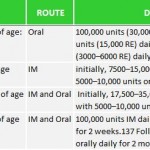CASE STUDY
A 30 yr old male patient complaints night blindness and vomiting for 2 weeks.His past medical history is malabsorption syndrome, constipation, and high cholesterol and he is on Orlistat, Cholestyramine and Mineral oil(lab data BMI >30).
1)what is the most likely diagnosis
1-obesity 2 –vitamin A deficiency 3 – Xerophthalmia
a) 1 only
b) 2 and 3
c) 2 only
d) 1 and 2
e) 1 and 3
2)what actions you would recommend to the patient.
1-start oral vitamin A
2- start IM vitamin A
3 – start IV vitamin A
a) 1 only
b) 2 and 3
c) 2 only
d) 1 and 2
e) 1 and 3
3) IM vitamin A is prescribed by the doctor.what drug-related problem you identify with the regimen.
1- Orlistat decreases vitamin A GI absorption
2-Mineral oil May impair absorption of vitamin A a
Avoid concomitant use
3- Cholestyramine May result in increased absorption of vitamin A
a) 1 only
b) 2 and 3
c) 2 only
d) 1 and 2
e) 1 and 3
STUDY TOPIC
1 Uses for Vitamin A
2 Vitamin A deficiency diagnosis
3 Administration
4 dosing
1 Uses for Vitamin A
Used to treat and prevent symptoms of vitamin A deficiency such as a xerophthalmia and night blindness
Used as a dietary supplement to prevent vitamin A deficiency in patients with GI diseases (e.g., malabsorption syndromes) and those with abnormal storage and transport of vitamin A (e.g., abetalipoproteinemia, protein deficiency, diabetes mellitus, hyperthyroidism, fever, liver disease, cystic fibrosis with hepatic involvement).a
high-dose vitamin A (50,000–200,000 units, depending on age) has been recommended in certain high-risk populations (i.e., postpartum women, children), with reduced doses recommended for pregnant women
patients with active xerophthalmia (e.g., night blindness, conjunctival xerosis with Bitot’s spots, corneal xerosis, corneal ulceration, keratomalacia) to be in imminent danger of corneal destruction and recommend immediate treatment with high dosages of vitamin A
Children with severe measles have been found to have low serum concentrations of vitamin A; WHO and AAP recommend that vitamin A supplements be given to all children with acute measles
2 Administration
Administer orally or by IM injection.127 133 137 a
Do not administer by IV injection.137
Oral administration generally preferred over parenteral therapy.127
Oral vitamin A capsules containing high strengths (e.g., 50,000 units) no longer commercially available in the US but may be available from various organizations (e.g., UNICEF, the International Dispensary Association [IDA]) for treatment of deficiencies in developing countries.127
Administer by IM injection when oral administration is not feasible (e.g., anorexia, nausea, vomiting, pre- and postoperative conditions) or when malabsorption syndrome is present.1
3 Vitamin A deficiency diagnosis
Serum retinol is typically maintained until hepatic stores are almost depleted. Values greater than 0.30 mg/L represent adequate liver stores, whereas values less than 0.10 mg/L indicate deficiency. Samples that come in contact with plastic tubing or have been exposed to excessive light may show low results.
Vitamin A toxicity occurs when retinol concentration exceeds the capacity of retinol binding protein (RBP). Individuals with compromised renal function can retain RBP and may, therefore, have moderate retinol elevations. Drugs which interfere with vitamin An analysis include probucol (Lorelco).
The use of RBP results in the classification of essentially the same children with VAD as does retinol, and RBP is an excellent surrogate for serum retinol. Considering the relative ease of measuring RBP with immunodiagnostic kits compared with that of serum retinol by HPLC, the use of RBP concentrations to assess VAD may be particularly advantageous in field settings. Consequently, measuring RBP concentrations may be a practical alternative to measuring serum retinol in population surveys assessing the prevalence of VAD.
4 dosing
5 Interactions for Vitamin A


